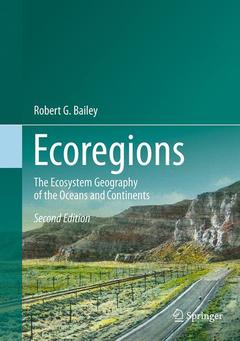Ecoregions (2nd Ed., 2nd ed. 2014) The Ecosystem Geography of the Oceans and Continents
Langue : Anglais
Auteur : Bailey Robert G.

Global warming and human-driven impacts are changing the World?s ecological zones. This book applies the principles described in Bailey?s Ecosystem Geography: From Ecoregions to Sites, 2nd ed. (Springer 2009, 1st ed. 1996) to describe and characterize the major terrestrial and aquatic ecological zones of the Earth. Bailey?s system for classifying these zones has been adopted by major organizations such as the U.S. Forest Service and The Nature Conservancy and this book is a significant contribution to a long tradition of classifying and studying the world?s ecological regions or ecoregions. It includes two color maps that show the major ecoregions of the continents and oceans. Also included are: - 106 illustrations with 55 in full color - A new chapter on mountains is included. - There are new sections that address concerns about how eco regions are changing under the relentless influence of humans and climate change - Another new feature is the discussion of using eco regional patterns to transfer research results and select sites for detecting climate change effects on ecosystem distribution - Use of ecoregional patterns to design monitoring networks and sustainable landscapes - Fire regimes in different regional ecosystems and their management implications.
1. Introduction 2. Oceanic Types and Their Controls.- 3. The Ecoregions of the Oceans.- 4. Continental Types and Their Controls.- 5. Ecoregions of the Continents: The Polar Ecoregions.- 6. The Humid Temperate Ecoregions.- 7. The Dry Ecoregions.- 8. The Humid Tropical Ecoregions.- 9. The Mountain Ecoregions.- 10. Ecoregion Redistribution under Climate Change.- 11. Continental Patterns and Boundaries.- 12. Application of Ecoregional Patterns.- 13. Fire Regimes at the Ecoregion Scale.- 14. Summary and Conclusions.- Appendix A: Air Masses and Frontal Zones.- Appendix B: Common and Scientific Names.- Appendix C. Conversion Factors.- Appendix D. Comparison of Ecoregion and Related Approaches.
Robert G. Bailey, born in 1939, received his PhD in Geography from the University of California, Los Angeles in 1971. An ecological geographer with U.S. Forest Service, Rocky Mountain Research Station, he was leader of the agency’s Ecosystem Management Analysis Center for many years. He has four decades of experience working with the theory and practice of ecosystem classification and mapping and its application to management. He is author of numerous publications on this and related subjects, including four books.
This is a new edition of a well-received text and it is essential reading for land managers, researchers and graduate students in ecology, landscape architecture and regional planning A significant contribution to a long tradition of classifying and studying the world’s ecological regions or ecoregions Details the use of eco regional patterns to design monitoring networks and sustainable landscapes Includes supplementary material: sn.pub/extras
Ouvrage de 180 p.
17.8x25.4 cm
Ouvrage de 180 p.
17.8x25.4 cm
© 2024 LAVOISIER S.A.S.



